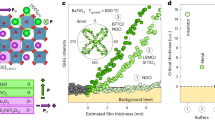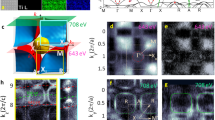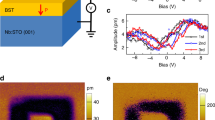Abstract
Coupling between different degrees of freedom, that is, charge, spin, orbital and lattice, is responsible for emergent phenomena in complex oxide heterostrutures1,2. One example is the formation of a two-dimensional electron gas (2DEG) at the polar/non-polar LaAlO3/SrTiO3 (LAO/STO)3,4,5,6,7 interface. This is caused by the polar discontinuity and counteracts the electrostatic potential build-up across the LAO film3. The ferroelectric polarization at a ferroelectric/insulator interface can also give rise to a polar discontinuity8,9,10. Depending on the polarization orientation, either electrons or holes are transferred to the interface, to form either a 2DEG or two-dimensional hole gas (2DHG)11,12,13. While recent first-principles modelling predicts the formation of 2DEGs at the ferroelectric/insulator interfaces9,10,12,13,14, experimental evidence of a ferroelectrically induced interfacial 2DEG remains elusive. Here, we report the emergence of strongly anisotropic polarization-induced conductivity at a ferroelectric/insulator interface, which shows a strong dependence on the polarization orientation. By probing the local conductance and ferroelectric polarization over a cross-section of a BiFeO3–TbScO3 (BFO/TSO) (001) heterostructure, we demonstrate that this interface is conducting along the 109° domain stripes in BFO, whereas it is insulating in the direction perpendicular to these domain stripes. Electron energy-loss spectroscopy and theoretical modelling suggest that the anisotropy of the interfacial conduction is caused by an alternating polarization associated with the ferroelectric domains, producing either electron or hole doping of the BFO/TSO interface.
This is a preview of subscription content, access via your institution
Access options
Access Nature and 54 other Nature Portfolio journals
Get Nature+, our best-value online-access subscription
$29.99 / 30 days
cancel any time
Subscribe to this journal
Receive 12 print issues and online access
$259.00 per year
only $21.58 per issue
Buy this article
- Purchase on Springer Link
- Instant access to full article PDF
Prices may be subject to local taxes which are calculated during checkout




Similar content being viewed by others
Data availability
The data that support the plots within this paper and other findings of this study are available from the corresponding authors upon reasonable request.
Change history
05 October 2018
In the version of this Letter originally published, the right-hand arrow in Fig. 3b was incorrectly labelled; see correction note for details. Also, ref. 29 was incorrectly included in the reference list; it has now been removed.
References
Hwang, H. Y. et al. Emergent phenomena at oxide interfaces. Nat. Mater. 11, 103–113 (2012).
Sulpizio, J. A., Ilani, S., Irvin, P. & Levy, J. Nanoscale phenomena in oxide heterostructures. Annu. Rev. Mater. Res. 44, 117–149 (2014).
Ohtomo, A. & Hwang, H. Y. A high-mobility electron gas at the LaAlO3/SrTiO3 heterointerface. Nature 427, 423–426 (2004).
Reyren, N. et al. Superconducting interfaces between insulating oxides. Science 317, 1196–1199 (2007).
Brinkman, A. et al. Magnetic effects at the interface between non-magnetic oxides. Nat. Mater. 6, 493–496 (2007).
Bert, J. A. et al. Direct imaging of the coexistence of ferromagnetism and superconductivity at the LaAlO3/SrTiO3 interface. Nat. Phys. 7, 767–771 (2011).
Salluzzo, M. et al. Origin of interface magnetism in BiMnO3/SrTiO3 and LaAlO3/SrTiO3 heterostructures. Phys. Rev. Lett. 111, 087204 (2013).
Chen, Y. Z. et al. Creation of high mobility two-dimensional electron gases via strain induced polarization at an otherwise nonpolar complex oxide interface. Nano Lett. 15, 1849–1854 (2015).
Niranjan, M. K., Wang, Y., Jaswal, S. S. & Tsymbal, E. Y. Prediction of a switchable two-dimensional electron gas at ferroelectric oxide interfaces. Phys. Rev. Lett. 103, 016804 (2009).
Yin, B., Puente, P. A., Qu, S. & Artacho, E. Two-dimensional electron gas at the PbTiO3/SrTiO3 interface: an ab initio study. Phys. Rev. B 92, 115406 (2015).
Marshall, S. J. et al. Conduction at a ferroelectric interface. Phys. Rev. Appl. 2, 051001 (2014).
Fredrickson, K. D. & Demkov, A. A. Switchable conductivity at the ferroelectric interface: nonpolar oxides. Phys. Rev. B 91, 115126 (2015).
Puente, P. A. et al. Model of two-dimensional electron gas formation at ferroelectric interfaces. Phys. Rev. B 92, 035438 (2015).
Zhang, Z., Wu, P., Chen, L. & Wang, J. L. First-principles prediction of a two dimensional electron gas at the BiFeO3/SrTiO3 interface. Appl. Phys. Lett. 99, 062902 (2011).
Tan, H. Y., Verbeeck, J., Abakumov, A. & Tendeloo, G. V. Oxidation state and chemical shift investigation in transition metal oxides by EELS. Ultramicroscopy 116, 24–33 (2012).
Rojac, T. et al. Domain-wall conduction in ferroelectric BiFeO3 controlled by accumulation of charged defects. Nat. Mater. 16, 322–327 (2017).
Yong, W. et al. Ferroelectric instability under screened Coulomb interactions. Phys. Rev. Lett. 109, 247601 (2012).
Nelson, C. T. et al. Domain dynamics during ferroelectric switching. Science 334, 968–971 (2011).
Ihlefeld, J. F. et al. Effect of domain structure on dielectric nonlinearity in epitaxial films. Appl. Phys. Lett. 97, 262904 (2010).
Lim, S. H. et al. Enhanced dielectric properties in single crystal-like thin films grown by flux-mediated epitaxy. Appl. Phys. Lett. 92, 012918 (2008).
Cen, C. et al. Nanoscale control of an interfacial metal–insulator transition at room temperature. Nat. Mater. 7, 298–302 (2008).
Kresse, G. & Joubert, D. From ultrasoft pseudopotentials to the projector augmented-wave method. Phys. Rev. B 59, 1758–1775 (1999).
Kresse, G. & Furthmuller, J. Efficient iterative schemes for ab initio total-energy calculations using a plane-wave basis set. Phys. Rev. B 54, 11169–11186 (1996).
Paudel, T. R., Jaswal, S. S. & Tsymbal, E. Y. Intrinsic defects in multiferroic BiFeO3 and their effect on magnetism. Phys. Rev. B 85, 104409 (2012).
Dudarev, S. L., Botton, G. A., Savrasov, S. Y., Humphreys, C. J. & Sutton, A. P. Electron-energy-loss spectra and the structural stability of nickel oxide: an LSDA+U study. Phys. Rev. B 57, 1505–1509 (1998).
Chen, L. Q. Phase-field model of phase transitions/domain structures in ferroelectric thin films: a review. J. Am. Ceram. Soc. 91, 1835–1844 (2008).
Li, Y. L., Hu, S. Y., Liu, Z. K. & Chen, L. Q. Effect of substrate constraint on the stability and evolution of ferroelectric domain structures in thin films. Acta Mater. 50, 395–411 (2002).
Li, Y. L., Hu, S. Y., Liu, Z. K. & Chen, L. Q. Effect of electrical boundary conditions on ferroelectric domain structures in thin films. Appl. Phys. Lett. 81, 427–429 (2002).
Acknowledgements
The work was supported by the Department of Energy (DOE), Office of Basic Energy Sciences, Division of Materials Sciences and Engineering under award DE-SC0014430 and partially by the National Science Foundation (NSF) under grants DMR-1506535 and DMR-1629270. L.X. was supported by the National Basic Research Program of China (grant no. 2015CB654901) and National Natural Science Foundation of China (grant no. 51302132). The research at the University of Nebraska-Lincoln was supported by the NSF through the Nebraska Materials Science and Engineering Center (MRSEC) under grant DMR-1420645. J.K., H.W. and R.Q.W. acknowledge support of DOE-BES (grant no. DE-272 FG02-05ER46237) and computing allocation by NERSC. The work at Penn State is supported by the US Department of Energy under award DE-FG02-07ER46417. The work at Cornell University was supported by the NSF (Nanosystems Engineering Research Center for Translational Applications of Nanoscale Multiferroic Systems) under grant EEC-1160504 (C.H. and D.G.S.). Substrate preparation was performed in part at the Cornell Nanoscale Facility, a member of the National Nanotechnology Coordinated Infrastructure (NNCI), which is supported by the NSF (grant ECCS-1542081). The authors would also like to acknowledge the University of California, Irvine’s Materials Research Institute (IMRI) for the use of TEM facilities. Y.Z. would like to thank J. R. Jokisaari for his initial work and help on the PFM measurements carried out at the University of Michigan. The authors also thank T. Aoki (University of California, Irvine) for his help on EELS measurements.
Author information
Authors and Affiliations
Contributions
X.Q.P. and Y.Z. conceived this project and designed experiments. Y.Z. and H.D.L. carried out the scanning probe microscopy experiments and data analysis supervised by A.G. and X.Q.P. X.X.Y., Y.Z. and L.X. carried out the TEM and EELS studies supervised by X.Q.P. T.R.P., J.W.K. and H.W. performed the first-principles modelling supervised by E.Y.T. and R.Q.W. X.X.C carried out the phase-field simulations supervised by L.-Q.C. Thin films were grown by C.H. supervised by D.G.S. L.Z.L. and M.J.X. participated in the analysis of experimental data. Y.Z., H.D.L., X.Q.P., A.G. and E.Y.T wrote the manuscript. All authors discussed the results and commented on the manuscript.
Corresponding authors
Ethics declarations
Competing interests
The authors declare no competing interests.
Additional information
Publisher’s note: Springer Nature remains neutral with regard to jurisdictional claims in published maps and institutional affiliations.
Supplementary Information
Supplementary Information
Supplementary Figures 1–11, Supplementary Notes 1–3
Rights and permissions
About this article
Cite this article
Zhang, Y., Lu, H., Xie, L. et al. Anisotropic polarization-induced conductance at a ferroelectric–insulator interface. Nature Nanotech 13, 1132–1136 (2018). https://doi.org/10.1038/s41565-018-0259-z
Received:
Accepted:
Published:
Issue Date:
DOI: https://doi.org/10.1038/s41565-018-0259-z
This article is cited by
-
In-plane charged antiphase boundary and 180° domain wall in a ferroelectric film
Nature Communications (2023)
-
Probing charge density in materials with atomic resolution in real space
Nature Reviews Physics (2022)
-
A Comprehensive FIB Lift-out Sample Preparation Method for Scanning Probe Microscopy
Nanomanufacturing and Metrology (2022)
-
Emergent properties at oxide interfaces controlled by ferroelectric polarization
npj Computational Materials (2021)
-
Direct observation of polarization-induced two-dimensional electron/hole gases at ferroelectric-insulator interface
npj Quantum Materials (2021)



